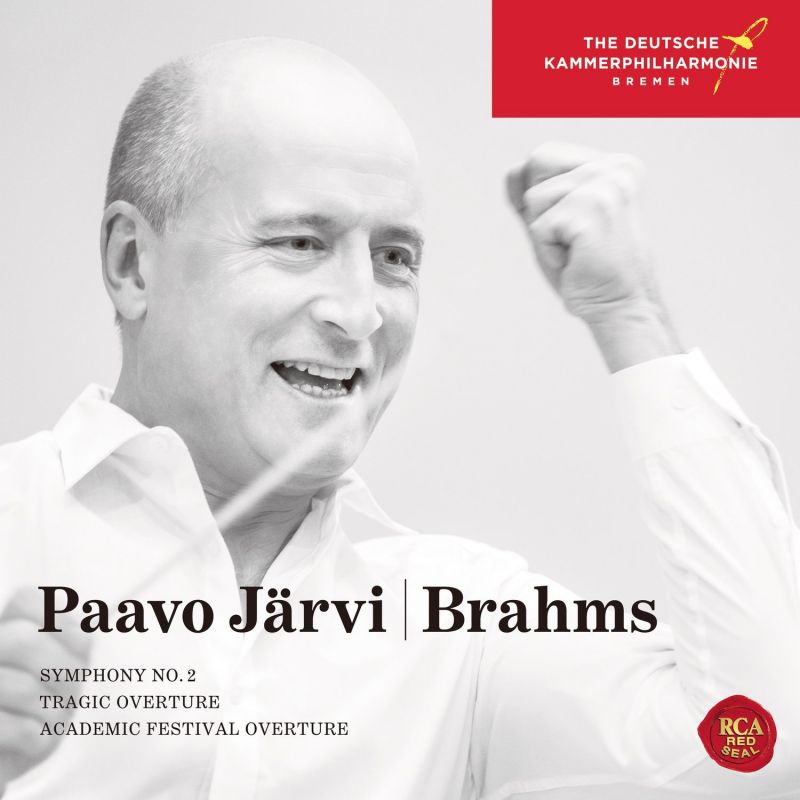BRAHMS Symphony No 2 (Järvi)
View record and artist detailsRecord and Artist Details
Composer or Director: Johannes Brahms
Genre:
Orchestral
Label: Sony Classical
Magazine Review Date: 01/2018
Media Format: CD or Download
Media Runtime: 67
Mastering:
DDD
Catalogue Number: 88985 459462

Tracks:
| Composition | Artist Credit |
|---|---|
| Symphony No. 2 |
Johannes Brahms, Composer
Deutsche Kammerphilharmonie, Bremen Johannes Brahms, Composer Paavo Järvi, Conductor |
| Tragic Overture |
Johannes Brahms, Composer
Deutsche Kammerphilharmonie, Bremen Johannes Brahms, Composer Paavo Järvi, Conductor |
| Academic Festival Overture |
Johannes Brahms, Composer
Deutsche Kammerphilharmonie, Bremen Johannes Brahms, Composer Paavo Järvi, Conductor |
Author: Richard Osborne
With the two overtures, Järvi’s lack of experience as a theatre conductor may be a factor. Brahms’s students are surely more richly drawn, and deserve to be better characterised, than they are in this spick and span account of the Academic Festival Overture. And that’s the easier of the two; for as Sir Adrian Boult once remarked, the Tragic Overture, though not difficult to play, is unusually difficult to ‘bring off’.
I think here of the central development, where Brahms halves the tempo and conjures a mood reminiscent of those lines in Robert Frost’s ‘Birches’ about the times when he is ‘weary of considerations’ and ‘life is too much like a pathless wood’. Not that everyone sees meaning here. No less a Brahmsian than Karl Geiringer thought the entire overture ‘colourless’. If you share such misgivings, Järvi’s performance might be for you.
No one has claimed that the Second Symphony lacks colour. Here the inner movements are beautifully done but in the finale one is aware (not for the first time) of a worrying lack of weight in the string sound and the sound palettes they can draw on. How, for example, does one create the grey, before-dawn chill of the più tranquillo which prefaces the finale’s recapitulation if the entire movement has been so sparingly painted, more an essay in grisaille than a painting in oils? And this has knock-on effects. How can the all-important trombones bring to the symphony’s jubilant end the weighty tones the great Brahms orchestras in Vienna, Berlin and Leipzig are licensed to unleash?
The opening movement poses other questions. Is this Eden and, if so, what are we to make of Brahms’s evident sense of troubles within? In Järvi’s case, not a lot. His is an essentially lyrical view of the music, one that’s reinforced by his decision to double the length of the mainly lyric exposition by taking the first-movement repeat. By the time we reach the great horn threnody near the movement’s end, it’s not entirely clear why it’s there, such has been the downplaying of the movement’s stormier developments.
Explore the world’s largest classical music catalogue on Apple Music Classical.
Included with an Apple Music subscription. Download now.

Gramophone Digital Club
- Digital Edition
- Digital Archive
- Reviews Database
- Events & Offers
From £9.20 / month
Subscribe
Gramophone Club
- Print Edition
- Digital Edition
- Digital Archive
- Reviews Database
- Events & Offers
From £11.45 / month
Subscribe
If you are a library, university or other organisation that would be interested in an institutional subscription to Gramophone please click here for further information.






